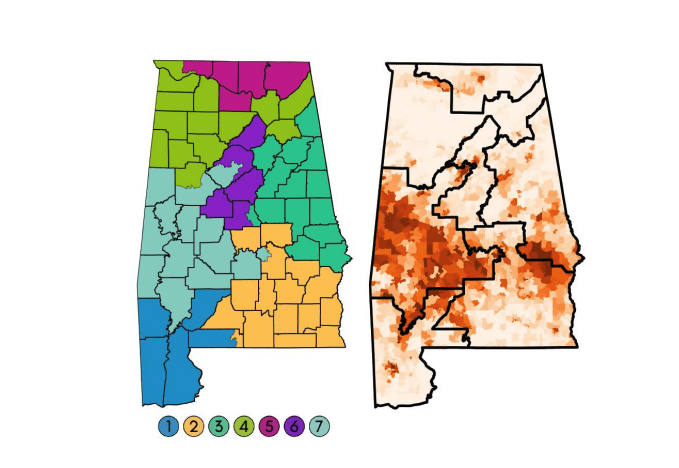Supreme Court ruling sends Alabama back to the drawing board
Published 12:00 am Saturday, June 10, 2023

- The Milligan plaintiffs rely on the testimony of expert witness Dr. Moon Duchin who shared proposed plans to help establish that Black voters as a group are “sufficiently large and geographically compact to constitute a majority in some reasonably configured legislative district.”
WASHINGTON, D.C. — The U.S. Supreme Court ruled June 8 that Alabama’s recently enacted congressional map violates the Voting Rights Act by not adding an additional majority-Black district to accommodate the state’s population growth.
In part, the VRA states that the right of U.S. citizens to vote shall not be denied or abridged … on “account of race, color or previous condition of servitude.”
The Supreme Court’s 5-4 decision in the case (Allen v. Milligan) affirmed a previous ruling of a lower district court indicating that despite the state’s population growth, the congressional map approved by the Republican-led legislature in 2021 (HB 1) was largely similar to the map a decade prior.
Redistricting
The ruling means the state has to go back to the drawing board. Effects are possible for counties around where the ruling is centered in District 7 but a domino effect could be possible for counties statewide.
“When they figure those two districts out there’ll inevitably be sort of a reverberation,” Jess Brown, a retired political science professor from Athens State University, said.
He said the legislature is likely to create a reapportionment committee of some sort to draw the seven house districts for the state. So, counties like Limestone and Cullman aren’t necessarily going to see massive change, but he doesn’t rule the possibility out.
“My guess is you’re going to see that any change in districts that have consequence are going to occur Birmingham and South,” he said. “Aderholt, Strong and — to a lesser extent — Rogers will be either not affected or minimally affected.”
Some of the proposed maps that were presented by the plantiff’s expert and used in the lower court’s opinion by the three-judge panel do show how changes could affect other parts of the state. For example, in two maps Limestone County moves from Dale Strong’s district 5 to Robert Aderholt’s district 4. Some of those maps show the two districts splitting the county in half. Because of Limestone County’s location right along the center line, it seems to be in a middle ground area that may see an unintentional shift due to the reorganization in the southern and central part of the state. Cullman County’s location doesn’t seem to bear as much of the change, but there is at least one scenario in the plantiff’s proposed maps that does show a split county.
“Limestone County would be, in my view, politically better off if the entire county was either in one congressman’s district or another one. Because when you start to divide a county, it means your portion of that congressman’s district gets to be rather small,” Brown said. “If you take all of Limestone County — one of the two fastest growing counties in the state, incidentally, percentage wise — if you put it in a congressman’s district, the entire thing, you’ve got a noticeable vote there.”
But, he said while it’s not likely, it’s also not impossible to see the state completely redraw all seven districts. He said the legislature is under pressure now to appease the three-judge panel from the district court that first struck down the map in January 2022.
“If the legislature doesn’t draw maps to satisfy the three-judge panel, the three-judge panel can hire their own reapportionment expert, their own computer people, cartographer, and everything and they can just hand the state a map and say ‘These are your congressional districts,’” Brown said. “It could be just simply a court ordered plan.”
Despite the Supreme Court’s ruling against the Republican state, Alabama GOP Chair John Wahl, from Limestone County, said the Party remains committed to competing in every district and will work to win all seven congressional seats when new districts are approved.
“Regardless of our disagreement with the court’s decision, we are confident the Alabama Legislature will redraw district lines that ensure the people of Alabama are represented by members who share their beliefs, while following applicable law,” Wahl said.
The Alabama NAACP headquarters sits in Limestone County and president Benard Simelton lauded the ruling, but noted that Congress should act on passing more federal voting laws, such as the proposed John Lewis Vote Rights Act.
“The SCOTUS agreed that Alabama maps did not provide for African Americans in Alabama to elect a person of their choice to represent them in Congress. ..,” Simelton said. “We renew our call for Congress to immediately restore Section 4b of the Voting Rights Act of 1965 by reintroducing and passing the John Lewis Voting Rights Act or similar legislation that will further ensure equal access to the ballot.”
The case
Evan Milligan, executive director at Alabama Forward — a statewide civic engagement group working to advance democracy — is the plaintiff in the case; Alabama Secretary of State Wes Allen is the defendant.
Only one of the state’s seven congressional districts is majority-Black, despite 2020 data revealing a nearly 27 percent Black population in the state, prompting lawsuits alleging racial gerrymandering and VRA violations.
Since 2010, U.S. Census data shows that the state’s Black alone population grew 3.6 percent in 10 years, while the white population decreased by -1.7 percent.
After hearings in federal district courts, the lower court concluded last year in a 227-page opinion that the question of whether HB1 likely violated the VRA was not “close.” The district court preliminarily enjoined Alabama from using the map in future elections, resulting in the State appealing to the U.S. Supreme Court.
The ruling
In its June 8 split opinion, the Supreme Court judges ruled against the State, indicating that plaintiffs proved VRA violations under what is called the “Gingles” conditions: that the “minority group must be sufficiently large and [geographically] compact to constitute a majority in a reasonably configured district; the minority group must be able to show that it is politically cohesive; and the minority must be able to demonstrate that the white majority votes sufficiently as a bloc to enable it … to defeat the minority’s preferred candidate.
“Plaintiff who demonstrates the three preconditions must then show, under the ‘totality of circumstances,’ that the challenged political process is not ‘equally open’ to minority voters,” the decision’s summary states.
Judges said the plaintiffs presented 11 alternative districting maps that Alabama could enact, at least one of which contained two majority-black districts that followed with traditional districting criteria.
Plaintiffs’ maps also contained equal populations, were contiguous, and respected existing political subdivisions; some of plaintiffs’ proposed maps split the same (or even fewer) county lines than the State’s map, the judges added.
The Supreme Court’s opinion also points to the lower district court’s note that, “on average, Black voters supported their candidates of choice with 92.3 percent of the vote” while “white voters supported Black-preferred candidates with 15.4 percent of the vote.”
An expert for Alabama’s defense testified at a district court hearing “that the candidates preferred by white voters in the areas that he looked at regularly defeat the candidates preferred by Black voters,” the Supreme Court opinion notes.
Judge Clarence Thomas, one of the four dissenting opinions, said that the state’s more than a quarter Black population is still slightly less than two-sevenths, referencing the two of seven Black congressional districts plaintiffs are calling for.
“Remarkably, the majority fails to acknowledge that two minority-controlled districts would mean proportionality, or even that Black Alabamians are about two-sevenths of the state,” Thomas said. “Yet that context is critical to the issues before us, not least because it explains the extent of the racial sorting the plaintiffs’ goal would require.”
Effects for other cases
Currently in Georgia, there are a handful of redistricting cases involving congressional, State House, and State Senate districts that the Alabama ruling could impact.
Fair Fight Action Executive Director Cianti Stewart-Reid said the ruling is a critical win for Black voters in Alabama and across the country where cases challenging racial gerrymandering are ongoing.
“Ten years ago, the Supreme Court voted down preclearance in Shelby v. Holder, a vital provision in Section 2 of the Voting Rights Act that would have prevented voters in Alabama from voting under gerrymandered maps in last year’s midterm election,” Stewart-Reid said. “Today, we celebrate this as a win for voters of color, and tomorrow we will continue the fight to ensure that voters everywhere are protected and have free and fair access to the ballot box.”
In December 2021, the American Civil Liberties Union, ACLU of Georgia and WilmerHale filed a federal lawsuit on behalf of Alpha Phi Alpha Fraternity, the Sixth District of the African Methodist Episcopal Church and individual Georgia voter. The suit indicates that state Senate and state House maps dilute the voting strength of Black Georgians because “they fail to include more than a half-dozen additional districts where Black voters could form a majority and have the opportunity to elect candidates of their choice.”
Legislators could have drawn at least half a dozen Black-majority Senate or House districts in southern and eastern parts of the Atlanta metro region, the Augusta area and the Southwest Georgia area — areas that saw a large increase in minority populations since the last redistricting cycle in 2011, ACLU representatives said. In part, the lawsuit specifically references Senate Districts 16, 17 and 23, stating that lawmakers untracked Black populations and combined them into predominately white areas.
“Given that the Georgia cases rest on similar principles to those decided in Alabama, we are hopeful that the court will fairly apply the law to the facts and order new maps, which better reflect the minority communities in Georgia,” Ken Lawler, chair of Fair Districts GA, said.
Added Kendra Cotton, CEO of New Georgia Project: “Today’s Supreme Court ruling in Allen v. Milligan is a welcome surprise from an institution who, lately, has been more interested in eroding our rights than protecting them. … The Supreme Court’s decision not only gives Black voters in Alabama more equal footing and representation as they go to the polls, but it also sets an important precedent for other southern states, including Georgia, that have voting rights cases currently pending in the courts.”





